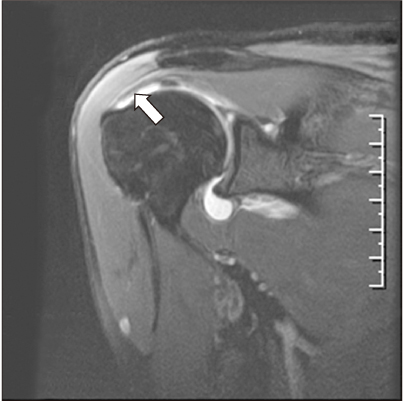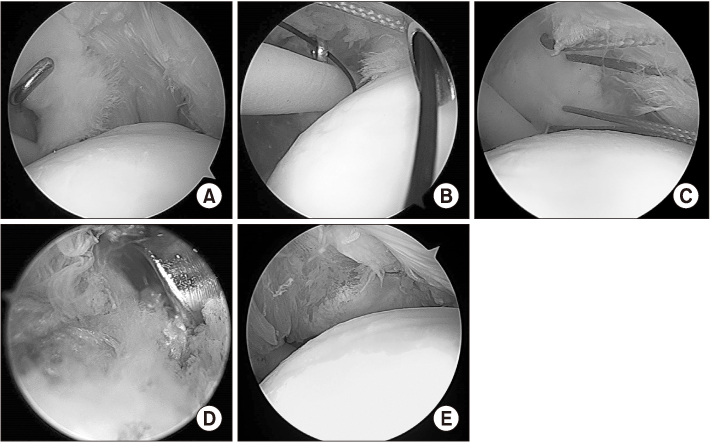J Korean Orthop Assoc.
2019 Aug;54(4):302-308. 10.4055/jkoa.2019.54.4.302.
Partial Thickness Rotator Cuff Tears of the Shoulder Related to the Sports
- Affiliations
-
- 1Department of Orthopedic Surgery, Hanyang University Guri Hospital, Guri, Korea. parkts@hanyang.ac.kr
- KMID: 2455498
- DOI: http://doi.org/10.4055/jkoa.2019.54.4.302
Abstract
- A painful shoulder is common among athletes, particularly those involved in overhead throwing. Professional and recreational athletes in throwing activities have an increased risk of partial thickness tears of the rotator cuff. The manuscript was to reviews the literature on the characteristics of injury, treatment strategies, and their results in throwing athletes.
Figure
Reference
-
1. Barnes DA, Tullos HS. An analysis of 100 symptomatic baseball players. Am J Sports Med. 1978; 6:62–67.
Article2. Hill JA. Epidemiologic perspective on shoulder injuries. Clin Sports Med. 1983; 2:241–246.
Article3. McCarroll JR, Gioe TJ. Professional golfers and the price they pay. Phys Sportsmed. 1982; 10:64–70.
Article4. Weiker GG. Club gymnastics. Clin Sports Med. 1985; 4:39–43.
Article5. Yokoe K, Nanajima H, Yamazaki Y. Injuries of the shoulder in volleyball players and javelin throwers. Orthop Trauma Surg. 1959; 22:351–359.6. Kennedy JC, Hawkins R. Swimmer's shoulder. Phys Sportsmed. 1974; 2:35–38.7. Strauss EJ, Salata MJ, Kercher J, et al. The arthroscopic management of partial-thickness rotator cuff tears: a systematic review of the literature. Arthroscopy. 2011; 27:568–580.
Article8. Fukuda H. Partial-thickness rotator cuff tears: a modern view on Codman's classic. J Shoulder Elbow Surg. 2000; 9:163–168.
Article9. Gschwend N, Ivosević-Radovanović D, Patte D. Rotator cuff tear--relationship between clinical and anatomopathological findings. Arch Orthop Trauma Surg. 1988; 107:7–15.10. King JW, Brelsford HJ, Tullos HS. Analysis of the pitching arm of the professional baseball pitcher. Clin Orthop Relat Res. 1969; 67:116–123.11. Pappas AM, Zawacki RM, Sullivan TJ. Biomechanics of baseball pitching. A preliminary report. Am J Sports Med. 1985; 13:216–222.12. Paley KJ, Jobe FW, Pink MM, Kvitne RS, ElAttrache NS. Arthroscopic findings in the overhand throwing athlete: evidence for posterior internal impingement of the rotator cuff. Arthroscopy. 2000; 16:35–40.
Article13. Jobe CM, Sidles J. Evidence for a superior glenoid impingement upon the rotator cuff. Paper presented at: Fifth International Conference on Surgery of the Shoulder. 1992 Jul 12-15; Paris, France. S19.14. Walch G, Boileau P, Noel E, Donell ST. Impingement of the deep surface of the supraspinatus tendon on the posterosuperior glenoid rim: an arthroscopic study. J Shoulder Elbow Surg. 1992; 1:238–245.
Article15. Crockett HC, Gross LB, Wilk KE, et al. Osseous adaptation and range of motion at the glenohumeral joint in professional baseball pitchers. Am J Sports Med. 2002; 30:20–26.
Article16. Osbahr DC, Cannon DL, Speer KP. Retroversion of the humerus in the throwing shoulder of college baseball pitchers. Am J Sports Med. 2002; 30:347–353.
Article17. Reagan KM, Meister K, Horodyski MB, Werner DW, Carruthers C, Wilk K. Humeral retroversion and its relationship to glenohumeral rotation in the shoulder of college baseball players. Am J Sports Med. 2002; 30:354–360.
Article18. Burkhart SS, Morgan CD, Kibler WB. The disabled throwing shoulder: spectrum of pathology Part I: pathoanatomy and biomechanics. Arthroscopy. 2003; 19:404–420.
Article19. Burkhart SS, Morgan CD, Kibler WB. The disabled throwing shoulder: spectrum of pathology. Part II: evaluation and treatment of SLAP lesions in throwers. Arthroscopy. 2003; 19:531–539.
Article20. Jobe FW, Kvitne RS, Giangarra CE. Shoulder pain in the overhand or throwing athlete. The relationship of anterior instability and rotator cuff impingement. Orthop Rev. 1989; 18:963–975.21. Burkhart SS, Morgan CD. The peel-back mechanism: its role in producing and extending posterior type II SLAP lesions and its effect on SLAP repair rehabilitation. Arthroscopy. 1998; 14:637–640.
Article22. Gainor BJ, Piotrowski G, Puhl J, Allen WC, Hagen R. The throw: biomechanics and acute injury. Am J Sports Med. 1980; 8:114–118.
Article23. Gowan ID, Jobe FW, Tibone JE, Perry J, Moynes DR. A comparative electromyographic analysis of the shoulder during pitching. Professional versus amateur pitchers. Am J Sports Med. 1987; 15:586–590.24. Dillman CJ, Fleisig GS, Andrews JR. Biomechanics of pitching with emphasis upon shoulder kinematics. J Orthop Sports Phys Ther. 1993; 18:402–408.
Article25. Fukuda H, Hamada K, Yamanaka K. Pathology and pathogenesis of bursal-side rotator cuff tears viewed from en bloc histologic sections. Clin Orthop Relat Res. 1990; 254:75–80.
Article26. Reilly P, Macleod I, Macfarlane R, Windley J, Emery RJ. Dead men and radiologists don't lie: a review of cadaveric and radiological studies of rotator cuff tear prevalence. Ann R Coll Surg Engl. 2006; 88:116–121.
Article27. Opsha O, Malik A, Baltazar R, et al. MRI of the rotator cuff and internal derangement. Eur J Radiol. 2008; 68:36–56.
Article28. Schaeffeler C, Mueller D, Kirchhoff C, Wolf P, Rummeny EJ, Woertler K. Tears at the rotator cuff footprint: prevalence and imaging characteristics in 305 MR arthrograms of the shoulder. Eur Radiol. 2011; 21:1477–1484.
Article29. Bigliani LU, Morrison DS, April EW. The morphology of the acromion and its relationship to rotator cuff tears. Orthop Trans. 1986; 10:216.30. Brownlow HC, Smith C, Corner T, Neen D, Pennington R. Pain and stiffness in partial-thickness rotator cuff tears. Am J Orthop (Belle Mead NJ). 2009; 38:338–340.31. Bryant L, Shnier R, Bryant C, Murrell GA. A comparison of clinical estimation, ultrasonography, magnetic resonance imaging, and arthroscopy in determining the size of rotator cuff tears. J Shoulder Elbow Surg. 2002; 11:219–224.
Article32. Neer CS 2nd. Anterior acromioplasty for the chronic impingement syndrome in the shoulder: a preliminary report. J Bone Joint Surg Am. 1972; 54:41–50.33. Andrews JR, Broussard TS, Carson WG. Arthroscopy of the shoulder in the management of partial tears of the rotator cuff: a preliminary report. Arthroscopy. 1985; 1:117–122.
Article34. DePalma AF. Surgery of the shoulder. Philadelphia: J. B. Lippincott;1950.35. Gartsman GM. Arthroscopic treatment of rotator cuff disease. J Shoulder Elbow Surg. 1995; 4:228–241.
Article36. Itoi E, Tabata S. Incomplete rotator cuff tears. Results of operative treatment. Clin Orthop Relat Res. 1992; 284:128–135.37. McConville OR, Iannotti JP. Partial-thickness tears of the rotator cuff: evaluation and management. J Am Acad Orthop Surg. 1999; 7:32–43.
Article38. Olsewski JM, Depew AD. Arthroscopic subacromial decompression and rotator cuff debridement for stage II and stage III impingement. Arthroscopy. 1994; 10:61–68.
Article39. Payne LZ, Altchek DW, Craig EV, Warren RF. Arthroscopic treatment of partial rotator cuff tears in young athletes. A preliminary report. Am J Sports Med. 1997; 25:299–305.40. Weber SC. Arthroscopic debridement and acromioplasty versus mini-open repair in the treatment of significant partial-thickness rotator cuff tears. Arthroscopy. 1999; 15:126–131.
Article41. Shaffer B, Huttman D. Rotator cuff tears in the throwing athlete. Sports Med Arthrosc Rev. 2014; 22:101–109.
Article42. Fukuda H, Mikasa M, Yamanaka K. Incomplete thickness rotator cuff tears diagnosed by subacromial bursography. Clin Orthop Relat Res. 1987; (223):51–58.
Article43. Löhr JF, Uhthoff HK. [Epidemiology and pathophysiology of rotator cuff tears]. Orthopade. 2007; 36:788–795. German.44. Uhthoff HK, Sano H. Pathology of failure of the rotator cuff tendon. Orthop Clin North Am. 1997; 28:31–41.
Article45. Ellman H. Diagnosis and treatment of incomplete rotator cuff tears. Clin Orthop Relat Res. 1990; (254):64–74.
Article46. Gonzalez-Lomas G, Kippe MA, Brown GD, et al. In situ transtendon repair outperforms tear completion and repair for partial articular-sided supraspinatus tendon tears. J Shoulder Elbow Surg. 2008; 17:722–728.
Article47. Oh LS, Wolf BR, Hall MP, Levy BA, Marx RG. Indications for rotator cuff repair: a systematic review. Clin Orthop Relat Res. 2007; 455:52–63.48. O'Brien SJ, Pagnani MJ, Fealy S, McGlynn SR, Wilson JB. The active compression test: a new and effective test for diagnosing labral tears and acromioclavicular joint abnormality. Am J Sports Med. 1998; 26:610–613.49. Neer CS 2nd. Impingement lesions. Clin Orthop Relat Res. 1983; (173):70–77.
Article50. Ben-Yishay A, Zuckerman JD, Gallagher M, Cuomo F. Pain inhibition of shoulder strength in patients with impingement syndrome. Orthopedics. 1994; 17:685–688.
Article51. Hawkins RJ, Abrams JS. Impingement syndrome in the absence of rotator cuff tear (stages 1 and 2). Orthop Clin North Am. 1987; 18:373–382.
Article52. Hawkins RJ, Kennedy JC. Impingement syndrome in athletes. Am J Sports Med. 1980; 8:151–158.
Article53. Silliman JF, Hawkins RJ. Classification and physical diagnosis of instability of the shoulder. Clin Orthop Relat Res. 1993; (291):7–19.
Article54. Jobe FW, Jobe CM. Painful athletic injuries of the shoulder. Clin Orthop Relat Res. 1983; (173):117–124.
Article55. Itoi E, Kido T, Sano A, Urayama M, Sato K. Which is more useful, the “full can test” or the “empty can test,” in detecting the torn supraspinatus tendon? Am J Sports Med. 1999; 27:65–68.
Article56. Hertel R, Ballmer FT, Lombert SM, Gerber C. Lag signs in the diagnosis of rotator cuff rupture. J Shoulder Elbow Surg. 1996; 5:307–313.
Article57. Gerber C, Hersche O. Tendon transfers for the treatment of irreparable rotator cuff defects. Orthop Clin North Am. 1997; 28:195–203.
Article58. Gerber C, Krushell RJ. Isolated rupture of the tendon of the subscapularis muscle. Clinical features in 16 cases. J Bone Joint Surg Br. 1991; 73:389–394.
Article59. Gerber C, Hersche O, Farron A. Isolated rupture of the subscapularis tendon. J Bone Joint Surg Am. 1996; 78:1015–1023.60. Scheibel M, Magosch P, Pritsch M, Lichtenberg S, Habermeyer P. The belly-off sign: a new clinical diagnostic sign for subscapularis lesions. Arthroscopy. 2005; 21:1229–1235.
Article61. Burkhart SS, Tehrany AM. Arthroscopic subscapularis tendon repair: technique and preliminary results. Arthroscopy. 2002; 18:454–463.62. de Jesus JO, Parker L, Frangos AJ, Nazarian LN. Accuracy of MRI, MR arthrography, and ultrasound in the diagnosis of rotator cuff tears: a meta-analysis. AJR Am J Roentgenol. 2009; 192:1701–1707.
Article63. Carvalho CD, Cohen C, Belangero PS, et al. Partial rotator cuff injury in athletes: bursal or articular? Rev Bras Ortop. 2015; 50:416–421.
Article64. Rudzki JR, Shaffer B. New approaches to diagnosis and arthroscopic management of partial-thickness cuff tears. Clin Sports Med. 2008; 27:691–717.
Article65. Gerber C, Schneeberger AG, Beck M, Schlegel U. Mechanical strength of repairs of the rotator cuff. J Bone Joint Surg Br. 1994; 76:371–380.
Article66. Reynolds SB, Dugas JR, Cain EL, McMichael CS, Andrews JR. Débridement of small partial-thickness rotator cuff tears in elite overhead throwers. Clin Orthop Relat Res. 2008; 466:614–621.
Article67. Klouche S, Lefevre N, Herman S, Gerometta A, Bohu Y. Return to sport after rotator cuff tear repair: a systematic review and meta-analysis. Am J Sports Med. 2016; 44:1877–1887.68. Liem D, Lichtenberg S, Magosch P, Habermeyer P. Arthroscopic rotator cuff repair in overhead-throwing athletes. Am J Sports Med. 2008; 36:1317–1322.
Article69. Mazoué CG, Andrews JR. Repair of full-thickness rotator cuff tears in professional baseball players. Am J Sports Med. 2006; 34:182–189.
Article70. Sonnery-Cottet B, Edwards TB, Noel E, Walch G. Rotator cuff tears in middle-aged tennis players: results of surgical treatment. Am J Sports Med. 2002; 30:558–564.
Article71. Armstrong A. Rotator cuff tears [Internet]. Rosemont (IL): American Academy of Orthopaedic Surgeons;2011. 05. cited 2015 Jan 20. Available from: http://orthoinfo.aaos.org/topic.cfm?topic=a00064.72. Goldberg JA, Chan KY, Best JP, Bruce WJ, Walsh W, Parry W. Surgical management of large rotator cuff tears combined with instability in elite rugby football players. Br J Sports Med. 2003; 37:179–181.
- Full Text Links
- Actions
-
Cited
- CITED
-
- Close
- Share
- Similar articles
-
- Partial-thickness rotator cuff tears: a review of current literature on evaluation and management
- Current Concept of Management of Partial-thickness Rotator Cuff Tear
- Comparative Study of MR-arthrography and Arthroscopy in Partial Thickness Rotator Cuff Tears
- Partial-Thickness Tear of Supraspinatus and Infraspinatus Tendon Revisited: Based on MR Findings
- Arthroscopic Partial Repair of Massive Contracted Rotator Cuff Tears



